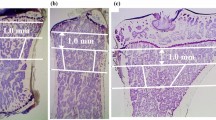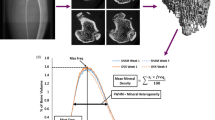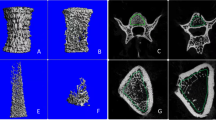Abstract
To clarify the local changes in bone formation and resorption during the early period after ovariectomy (OVX), 200 SD rats, 4 months of age, underwent OVX or sham surgeries and seven to nine rats from each group were terminated at 1, 3, 7, 11, 15, 19, 23, 28, 35, 63, and 91 days postsurgery after tetracycline labeling. Serum intact osteocalcin levels were measured. Undecalcified sections of the 5th lumbar body (L5) and the right proximal tibia were measured for trabecular bone area, the labeled perimeters and the interlabeling distances after Villanueva's staining. On the 4th lumbar body (L4) and the left proximal tibia, undecalcified sections were measured for the trabecular osteoclast, by tartrate-resistant acid phosphatase staining. The uterine horns were atrophied on the 3rd postovariectomy day (day 3). Serum osteocalcin levels increased on day 7 and reached the highest value on day 23. In either L5 or the metaphysis of the proximal tibia, trabecular bone volume (BV/TV) significantly decreased on day 15. The trabecular bone loss on day 28 was approximately 50% in the tibia and 15% in the L5. In either the lumbar or the tibia, osteoclast numbers significantly increased at day 3, and peaked between days 15 and 23.In the tibia, however, the bone formation rates (BFR/BS) were significantly reduced, on the 3rd and 7th postsurgical days compared with the start value for both the OVX and sham groups. The BFR/BS values in L5 did not decrease during the first 7 days in either group. The BFR/BS values were then increased for both L5 and the tibia after day 7. These data clearly demonstrated that the local bone turnover 7 days post-OVX was identical in the proximal tibia and the lumbar vertebra. In the proximal tibia, however, it may be suggested that the increased bone resorption and reduced formation within 7 days after OVX due to the combined effects of both an estrogen deficiency and the surgical intervention would possibly play a critical role in the greater magnitude of the trabecular bone loss.
Similar content being viewed by others
References
Guidelines for preclinical and clinical evaluation of agents used in the prevention or treatment of postmenopausal osteoporosis. Division of Metabolism and Endocrine Drug Products, Food and Drug Administration, April 1994
Kalu DN (1991) The ovariectomized rat model of postmenopausal bone loss. Bone Miner 15: 175–192.
Wronski TJ, Dann LM, Horner SL (1989) Time course of vertebral osteopenia in ovariectomized rats. Bone 10:295–301
Wronski TJ, Cintron M, Dann LM (1988) Temporal relationship between bone loss and increased bone turnover in ovariectomized rats. Calcif Tissue Int 43: 179–183, 1988
Dempster DW, Birchman R, Xu R, Lindsay R, Shen V (1995) Temporal changes in cancellous bone structure of rats immediately after ovariectomy. Bone 16:157–161
Faugere MC, Friedler RM, Fanti P, Mallluche HH (1990) Bone changes occurring early after cessation of ovarian function in beagle dogs: a histomorphometric study employing sequential biospsies. J Bone Miner Res 5:263–272
Kimble RB, Vannice JL, Bloedow DC, Thompson RC, Hopfer W, Kung VT, Brownfield C, Pacifici R (1994) Interleukin-1 receptor antagonist decreases bone loss and bone resorption in ovariectomized rats. J Clin Invest 93:1959–1967
Ikeda T, Shigeno, C, Kasai R, Kohno H, Ohta S, Okumura H, Konishi J, Yamamuro T (1993) Ovariectomy decreases the mRNA levels of transforming growth factor-b1 increases the mRNA levels of osteocalcin in rat bone in vivo. Biochem Biophys Res Comm 194:1228–1233
Jilka RL, Hangoc G, Girasole G, Passeri G, Williams DC, Abrams JS, Boyce B, Broxmeyer H, Manolagas SC (1992) Increased osteoclast development after estrogen loss: mediation by interleukin-6. Science 257:88–91
Hosoda K, Eguchi H, Nakamoto T, Kubota T, Honda H, Jindai S, Hasegawa R, Kiyoki M, Yamaji T, Shiraki M (1992) Sand-wich immunoassay for intact human osteocalcin. Clin Chem 38:2233–2238
Tsurukami H, Nakamura T, Suzuki K, Sato K, Higuchi Y, Nishii Y (1994) A novel synthetic vitamin D analogue, 2b-(3-hydroxypropoxy)la,25-dihydroxyvitamin D3 (ED-71), increases bone mass by stimulating the bone formation in normal and ovariectomized rats. Calcif Tissue Int 54:142–149
Andersson GN, Marks SJ (1989) Tartrate-resistant acid ATPase as a cytochemical marker for osteoclast. J Histochem Cytochem 37:115–117
Lane N, Coble T, Kimmel DB (1990) Effect of naproxen on cancellous bone in overiectomized, rats. J Bone Miner Res 5: 1029–1035
Parfitt AM, Mathews CH, Villanueva AR, Kleerkoper M, Frame B, Rao DS (1983) Relationship between surface, volume and thickness of iliac trabecular bone in aging and osteoporosis: implications for the microanatomic and cellular mechanisms, for bone loss. J Clin Invest 72:1396–1408.
Parfitt AM, Drezner MK, Glorieux FH, Kanis JA, Malluche H, Meunier PJ (1987) Bone histomorphometry: standardization of nomenclature, symbols, and units. Report of the ASBMR histomorphometry nomenclature committee. J Bone Miner Res 2:596–610
Murakami H, Nakamura T, Tsurukami H, Abe M, Barbier A, Suzuki K (1994) Effects of tiludronate on bone mass, structure, and turnover at the epiphyseal, primary, and secondary spongiosa in the proximal tibia of growing rats after sciatic neurectomy. J Bone Miner Res 9:1355–1364
Ismail F, Epstein S, Fallon MD, Thomas SB, Reihardt TA (1988) Serum bone Gla protein and the vitamin D endocrine system in the oophorectomized rat. Endocrinology 122:624–630
Weinreb M, Rodan GA, Thompson DD (1989) Osteopenia in the immobilized rat hind limb is associated with increased bone resorption and decreased bone formation. Bone 10:187–194
Landry M, Fleisch H (1964) The influence of immobilization on bone formation as evaluated by osseous incorporation, of tetracycline. J Bone Joint Surg (Br) 46:764–771
Wronski TJ, Moorey ER (1983) Inhibition of cortical and trabecular bone formation in the long bones of immobilized monkeys. Clin Orthop 181:269–276
Vico L, Chappard D, Alexandre C, Palle S, Minaire P, Riffat G, Morukov B, Rakhmanov, S (1987) Effects of 120 day period of bed rest on bone mass and bone cell activities in man: attempts at countermeasure. Bone Miner 2:383–394
Neidhart M, Fluckiger EW (1992) Hyperprolactinaemia in hypophysectomized or intact male rats and the development of adjuvant arthritis. Immunology 77:449–455
Stashenko P, Dewhrist EF, Rooney ML, Dejardins LA, Heeley D (1987) Interleukin-1β is a potent inhibitor of bone formation in vitro. J Bone Miner Res 2:559–565
Bikle DD, Harris J, Halloran, BP, Morey-Holton ER (1994) Skeletal unloading induces resistance to insulin-like growth factor I. J Bone Miner Res: 1789–1796
Keila S, Pitaru S, Grosskopf A, Weinreb M (1994) Bone marrow from, mechanically unloaded rat bones expresses, reduced osteogenic capacity in vitro. J Bone Miner Res 9:321–327
Zhang R, Supowit SC, Klein GL, Zhaofeng L, Christensen MD, Lozano R, Simmons DJ (1995) Rat tail suspension reduces messenger RNA level for growth factors and osteopontin and decreases the osteoblastic differentiation of bone marrow stromal cells. J Bone Miner Res 10:415–423
Wakley GK, Baum BL, Hannon KS, Turner RT (1988) The effects of tamoxifen on the osteopenia induced by sciatic neurectomy in the rat: a histomorphometric study. Calcif Tissue Int 43:383–388
Yamaura M, Nakamura T, Kanou A, Miura T, Ohara H, Suzuki K (1994) The effect of 17β-estradiol treatment on the mass and the turnover of bone in ovariectomized rats taking a mild dose of thyroxin. Bone Miner 24:33–42
Author information
Authors and Affiliations
Rights and permissions
About this article
Cite this article
Yamaura, M., Nakamura, T., Tsurukami, H. et al. Local bone turnover in the metaphysis of the proximal tibia and the lumbar vertebra during the early periods after ovariectomy in rats. Calcif Tissue Int 58, 52–59 (1996). https://doi.org/10.1007/BF02509546
Received:
Accepted:
Issue Date:
DOI: https://doi.org/10.1007/BF02509546




